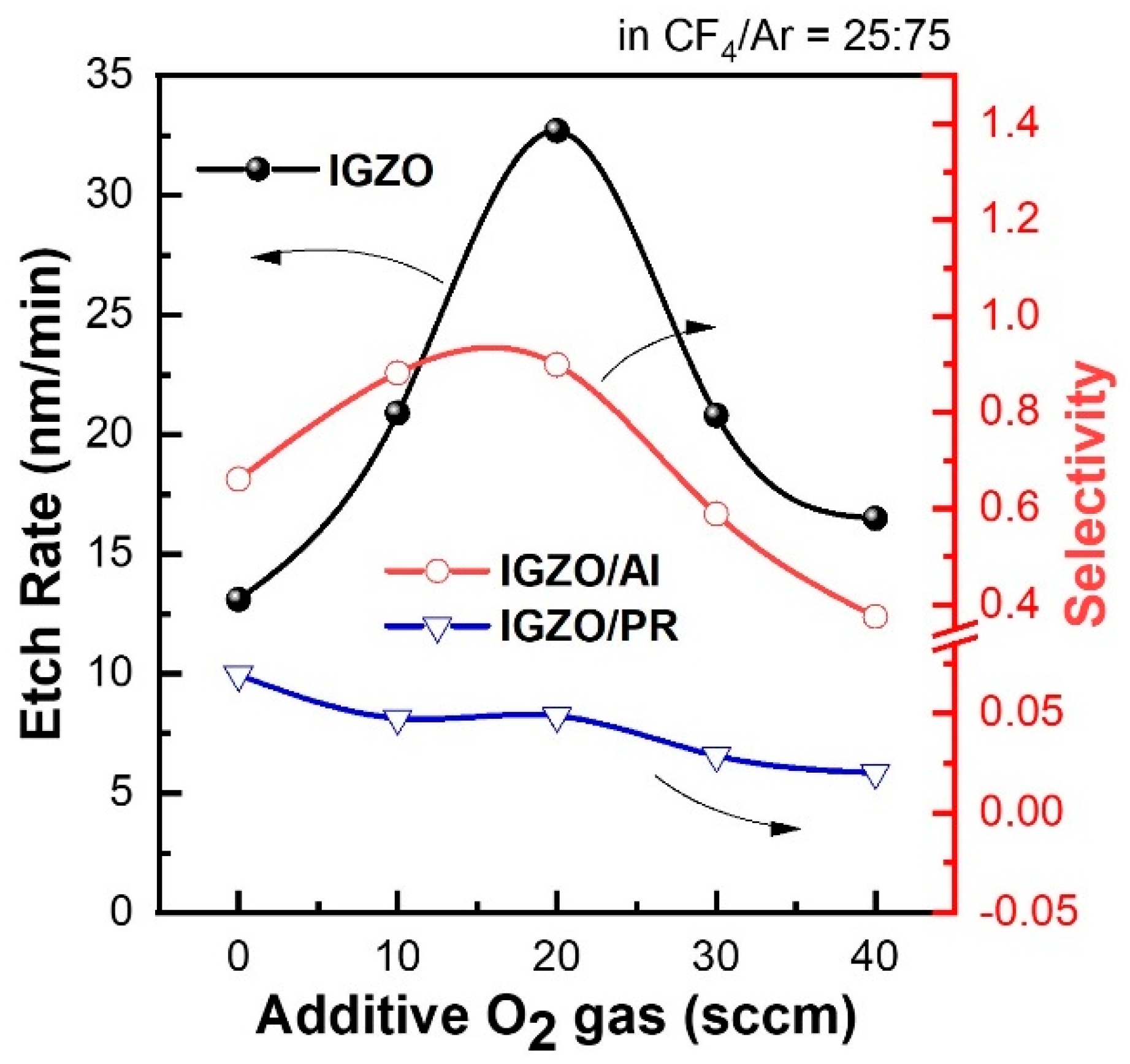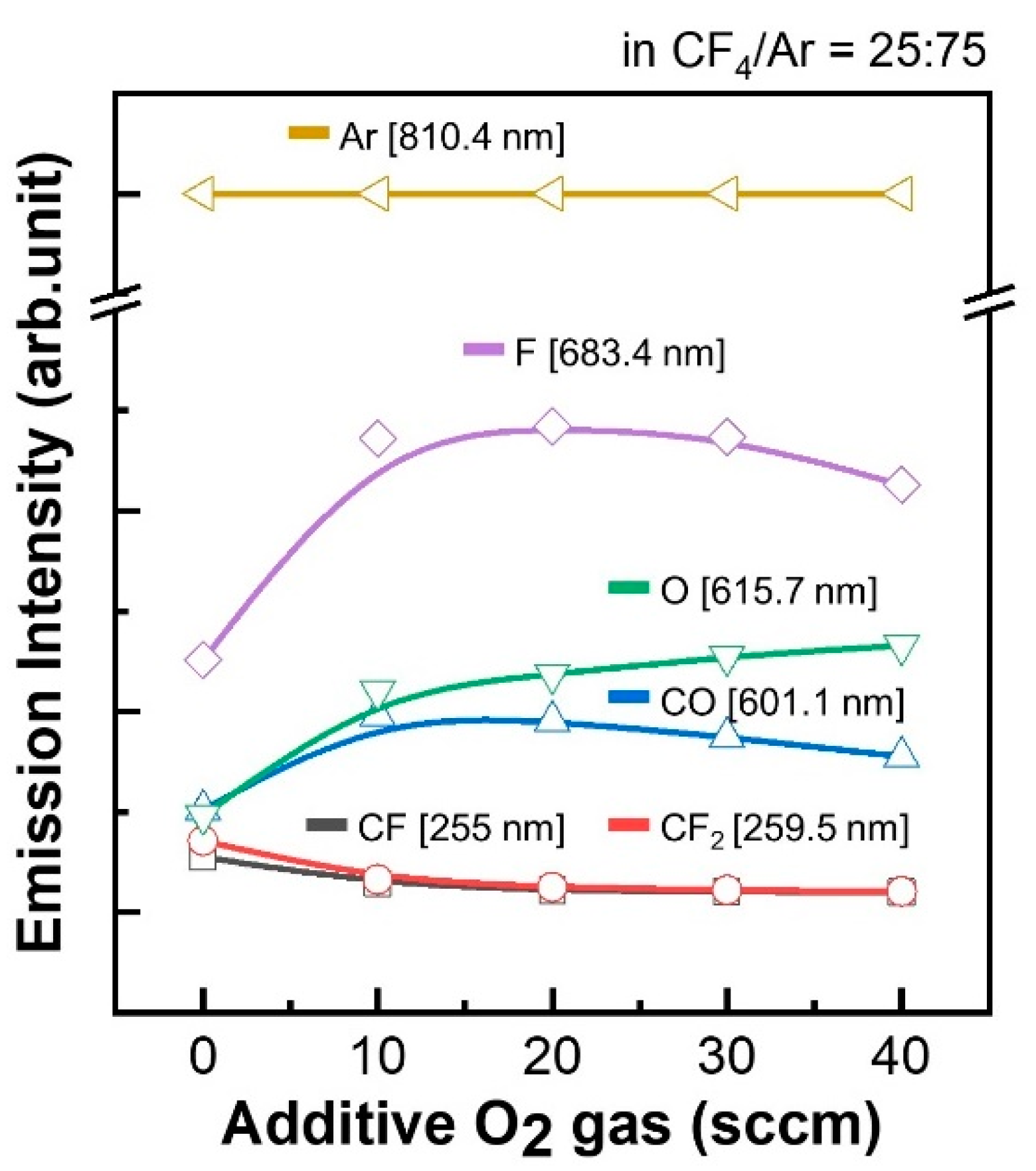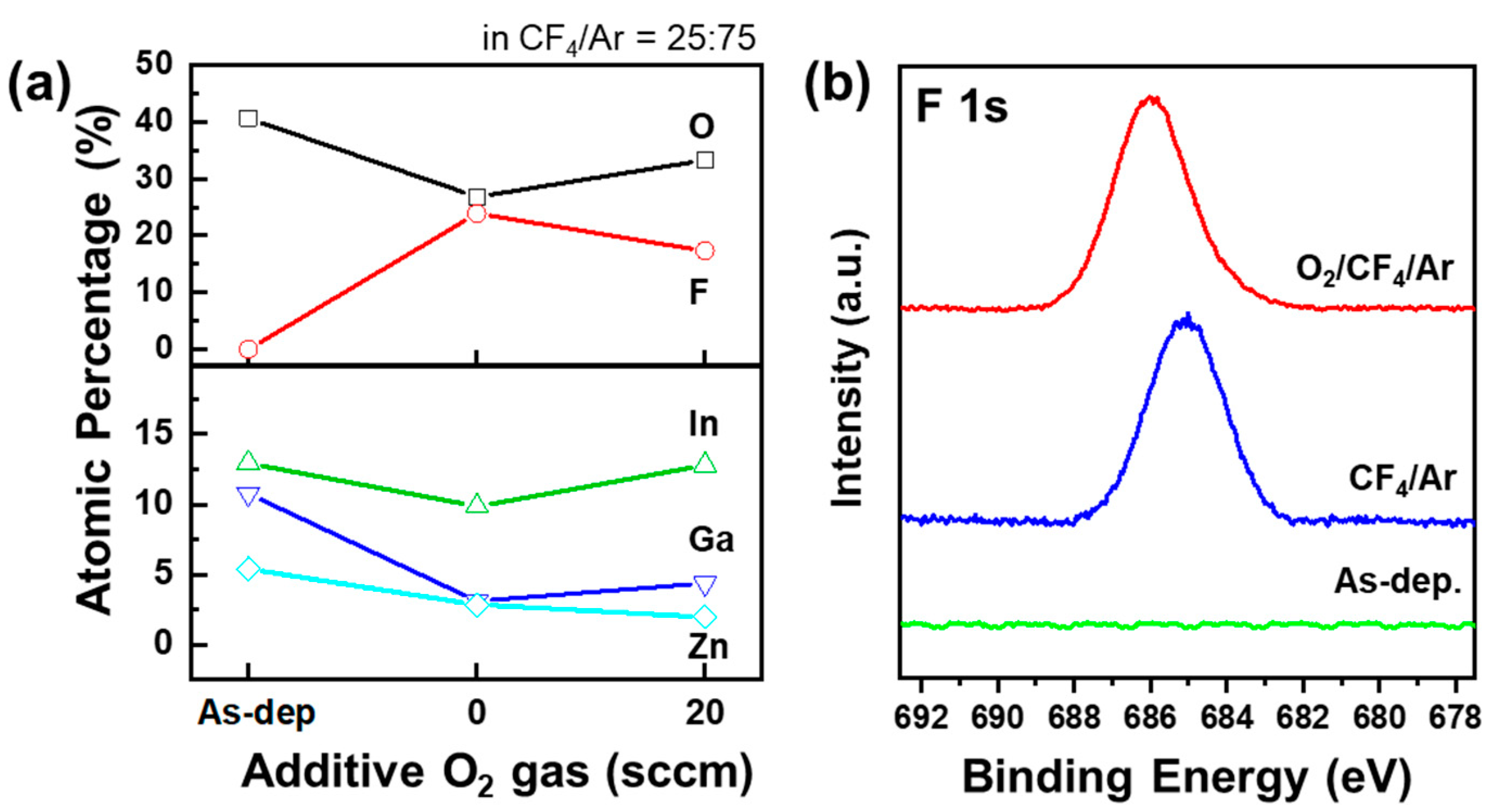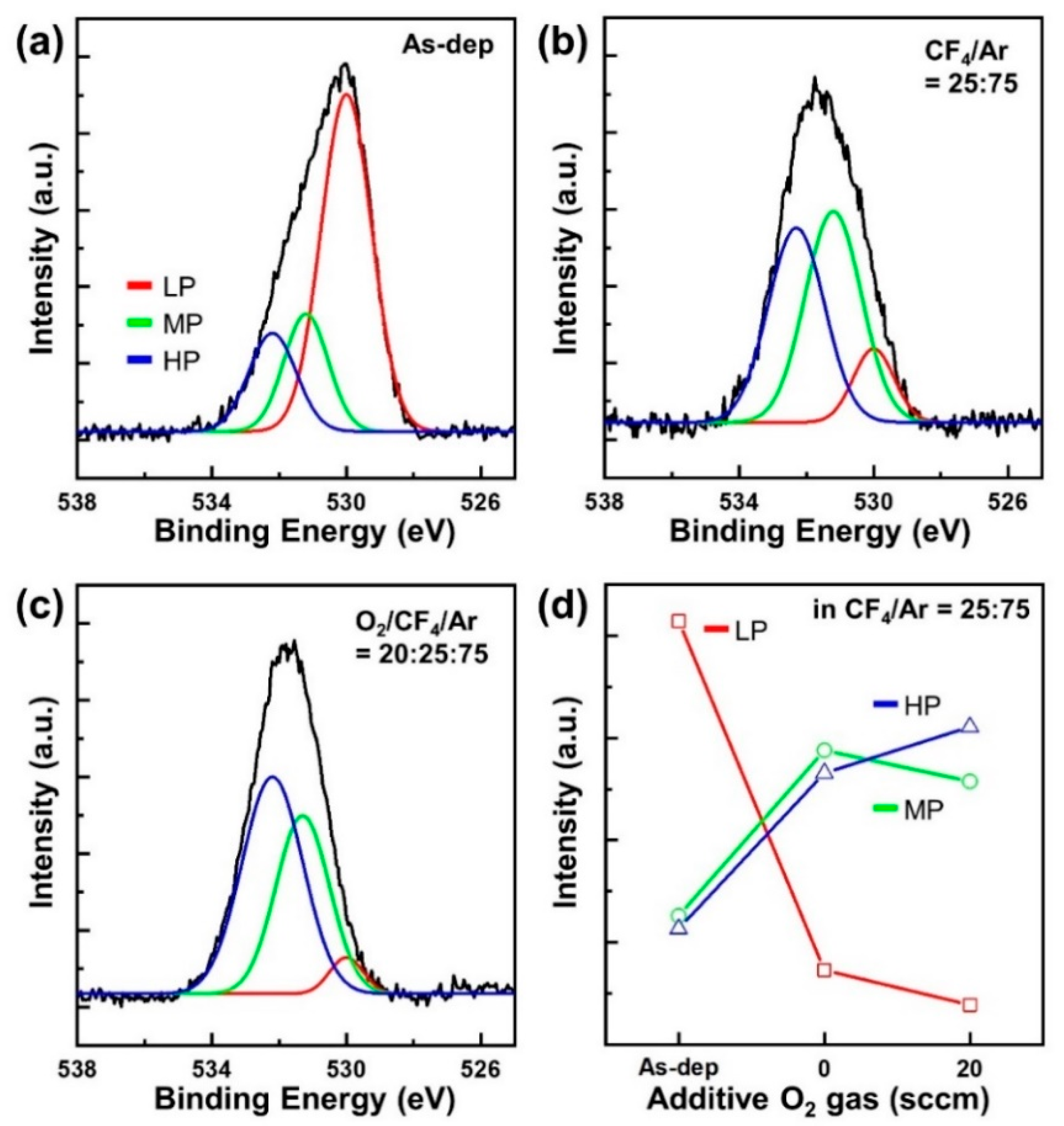Etching Characteristics and Changes in Surface Properties of IGZO Thin Films by O2 Addition in CF4/Ar Plasma
Abstract
:1. Introduction
2. Materials and Methods
3. Results and Discussion
4. Conclusions
Supplementary Materials
Author Contributions
Funding
Institutional Review Board Statement
Informed Consent Statement
Data Availability Statement
Conflicts of Interest
References
- Wager, J.F.; Hoffman, R. Thin, fast, and flexible. IEEE Spectr. 2011, 48, 42–56. [Google Scholar] [CrossRef]
- Troughton, J.G.; Downs, P.; Price, R.; Atkinson, D. Densification of a-IGZO with low-temperature annealing for flexible electronics applications. Appl. Phys. Lett. 2017, 110, 011903. [Google Scholar] [CrossRef]
- Sheng, J.; Hong, T.; Lee, H.M.; Kim, K.; Sasase, M.; Kim, J.; Hosono, H.; Park, J.S. Amorphous IGZO TFT with high mobility of similar to 70 cm2/(V s) via vertical dimension control using PEALD. ACS Appl. Mater. Interfaces 2019, 11, 40300–40309. [Google Scholar] [CrossRef]
- Choi, I.M.; Kim, M.J.; On, N.; Song, A.; Chung, K.B.; Jeong, H.; Park, J.K.; Jeong, J.K. Achieving high mobility and excellent stability in amorphous In–Ga–Zn–Sn–O thin-film transistors. IEEE Trans. Electron Devices 2020, 67, 1014–1020. [Google Scholar] [CrossRef]
- Kim, J.; Park, J.; Yoon, G.; Khushabu, A.; Kim, J.-S.; Pae, S.; Cho, E.-C.; Yi, J. Effect of IGZO thin films fabricated by Pulsed-DC and RF sputtering on TFT characteristics. Mater. Sci. Semicond. Process. 2020, 120, 105264. [Google Scholar] [CrossRef]
- Alford, T.L.; Gadre, M.J.; Vemuri, R.N.P. Improved mobility and transmittance of room-temperature-deposited amorphous indium gallium zinc oxide (a-IGZO) films with low-temperature postfabrication anneals. JOM 2013, 65, 519–524. [Google Scholar] [CrossRef]
- Lee, E.G.; Park, J.; Lee, S.-E.; Na, H.-J.; Cho, N.-K.; Im, C.; Cho, Y.H.; Kim, Y.S. Oxygen radical control via atmospheric pressure plasma treatment for highly stable IGZO thin-film transistors. IEEE Trans. Electron Devices 2020, 67, 3135–3140. [Google Scholar] [CrossRef]
- Hoshino, K.; Hong, D.; Chiang, H.Q.; Wager, J.F. Constant-voltage-bias stress testing of a-IGZO thin-film transistors. IEEE Trans. Electron Devices 2009, 56, 1365–1370. [Google Scholar] [CrossRef]
- Lee, J.H.; Kim, D.H.; Yang, D.J.; Hong, S.Y.; Yoon, K.S.; Hong, P.S.; Jeong, C.O.; Park, H.S.; Kim, S.Y.; Lim, S.K.; et al. World’s largest (15-inch) XGA AMLCD panel using IGZO oxide TFT. SID Int. Symp. Dig. Tech. 2008, 39, 625–628. [Google Scholar] [CrossRef]
- Nomura, K.; Aoki, T.; Nakamura, K.; Kamiya, T.; Nakanishi, T.; Hasegawa, T.; Kimura, M.; Kawase, T.; Hirano, M.; Hosono, H. Three-dimensionally stacked flexible integrated circuit: Amorphous oxide/polymer hybrid complementary inverter using n-type a-In-Ga-Zn-O and p-type poly-(9,9-dioctylfluorene-co-bithiophene) thin-film transistors. Appl. Phys. Lett. 2010, 96, 263509. [Google Scholar] [CrossRef]
- Oian, Z.; Ruan, C.; Xia, G.; Gong, H.; Wang, S. Low-temperature solution-processed InGaZnO thin film transistors by using lightwave-derived annealing. Thin Solid Film. 2021, 723, 138594. [Google Scholar]
- Benwadih, M.; Coppard, R.; Bonrad, K.; Klyszcz, A.; Vuillaume, D. High mobility flexible amorphous IGZO thin-film transistors with a low thermal budget ultra-violet pulsed light process. ACS Appl. Mater. Interfaces 2016, 8, 34513–34519. [Google Scholar] [CrossRef]
- Knobelspies, S.; Takabayashi, A.; Daus, A.; Cantarella, G.; Munzenrieder, N.; Troster, G. Improvement of contact resistance in flexible a-IGZO thin-film transistors by CF4/O2 plasma treatment. Solid State Electron. 2018, 150, 23–27. [Google Scholar] [CrossRef]
- Wei, S.; Wang, F.; Zou, X.; Wang, L.; Liu, C.; Liu, X.; Hu, W.; Fan, Z.; Ho, J.C.; Liao, L. Flexible quasi-2D perovskite/IGZO phototransistors for ultrasensitive and broadband photodetection. Adv. Mater. 2019, 32, e1907527. [Google Scholar] [CrossRef]
- Lee, S.; Song, Y.; Park, H.; Zaslavsky, A.; Paine, D.C. Channel scaling and field-effect mobility extraction in amorphous InZnO thin film transistors. Solid State Electron. 2017, 135, 94–99. [Google Scholar] [CrossRef]
- Cho, E.N.; Kang, J.H.; Yun, I. Contact resistance dependent scaling-down behavior of amorphous InGaZnO thin-film transistors. Curr. Appl. Phys. 2011, 11, 1015–1019. [Google Scholar] [CrossRef]
- Zheng, Y.; Li, G.; Wang, W.; Li, X.; Jiang, Z. Dry Etching characteristics of amorphous indium-gallium-zinc-oxide thin films. Plasma Sci. Technol. 2012, 14, 915–918. [Google Scholar] [CrossRef]
- Kim, K.; Efremov, A.; Lee, J.; Kwon, K.H.; Yeom, G.Y. Etching mechanisms of (In, Ga, Zn)O thin films in CF4/Ar/O2 inductively coupled plasma. J. Vac. Sci. Technol. A 2015, 33, 031601. [Google Scholar] [CrossRef] [Green Version]
- Park, W.; Whang, K.W.; Yoon, Y.G.; Kim, J.H.; Rha, S.H.; Hwang, C.S. High rate dry etching of InGaZnO by BCl3/O2 plasma. Appl. Phys. Lett. 2011, 99, 062110. [Google Scholar] [CrossRef]
- Park, J.C.; Jeong, O.G.; Kim, J.K.; Yun, Y.H.; Pearton, S.J.; Cho, H. Comparison of chlorine- and fluorine-based inductively coupled plasmas for dry etching of InGaZnO4 films. Thin Solid Film. 2013, 546, 136–140. [Google Scholar] [CrossRef]
- Joo, Y.H.; Jin, M.J.; Kim, S.K.; Um, D.S.; Kim, C.I. BCl3/Ar plasma etching for the performance enhancement of Al-doped ZnO thin films. Appl. Surf. Sci. 2021, 516, 149957. [Google Scholar] [CrossRef]
- Lin, D.; Su, W.C.; Chang, T.C.; Chen, H.C.; Tu, Y.F.; Zhou, K.J.; Hung, Y.H.; Yang, J.; Nu, I.N.; Tsai, T.M.; et al. Degradation behavior of etch-stopper-layer structured a-InGaZnO thin-film transistors under hot-carrier stress and illumination. IEEE Trans. Electron Devices 2021, 68, 556–559. [Google Scholar] [CrossRef]
- Ravi, S.K.; Sun, W.X.; Nandakumar, D.K.; Zhang, Y.X.; Tan, S.C. Optical manipulation of work function contrasts on metal thin films. Sci. Adv. 2018, 4, eaao6050. [Google Scholar] [CrossRef] [Green Version]
- Joo, Y.H.; Wi, J.H.; Lee, W.J.; Chung, Y.D.; Cho, D.H.; Kang, S.; Um, D.S.; Kim, C.I. Work function tuning of zinc-tin oxide thin films using high-density O2 plasma treatment. Coatings 2020, 10, 1026. [Google Scholar] [CrossRef]
- Wandelt, K. The local work function: Concept and implications. Appl. Surf. Sci. 1997, 111, 1–10. [Google Scholar] [CrossRef]
- Kim, M.; Jeong, J.H.; Lee, H.J.; Ahn, T.K.; Shin, H.S.; Park, J.S.; Jeong, J.K.; Mo, Y.G.; Kim, H.D. High mobility bottom gate InGaZnO thin film transistors with SiOx etch stopper. Appl. Phys. Lett. 2007, 90, 212114. [Google Scholar] [CrossRef]
- Joo, Y.H.; Kim, C.I. High-density plasma etching characteristics of indium-gallium-zinc oxide thin films in CF4/Ar plasma. Thin Solid Film. 2015, 583, 40–45. [Google Scholar] [CrossRef]
- Na, J.H.; Kitamura, M.; Arakawa, Y. High field-effect mobility amorphous InGaZnO transistors with aluminum electrodes. Appl. Phys. Lett. 2008, 93, 063501. [Google Scholar] [CrossRef]
- Lee, J.S.; Chang, S.; Koo, S.M.; Lee, S.Y. High-performance a-IGZO TFT with ZrO2 gate dielectric fabricated at room temperature. IEEE Electron. Device Lett. 2010, 31, 225–227. [Google Scholar]
- Akatsuka, H. Optical Emission Spectroscopic (OES) analysis for diagnostics of electron density and temperature in non-equilibrium argon plasma based on collisional-radiative mode. Adv. Phys. X 2019, 4, 1592707. [Google Scholar] [CrossRef] [Green Version]
- Lim, N.; Efremov, A.; Yeom, G.Y.; Kwon, K.H. On the etching characteristics and mechanisms of HfO2 thin films in CF4/O2/Ar and CHF3/O2/Ar plasma for nano-devices. J. Nanosci. Nanotechnol. 2014, 14, 9670–9679. [Google Scholar] [CrossRef] [Green Version]
- Nantel-Valiquette, M.; Kabouzi, Y.; Castanos-Martinez, E.; Makasheva, K.; Moisan, M.; Rostaing, J.C. Reduction of perfluorinated compound emissions using atmospheric pressure microwave plasmas: Mechanisms and energy efficiency. Pure Appl. Chem. 2006, 78, 1173–1185. [Google Scholar] [CrossRef]
- Kawamoto, Y.; Ogura, K.; Shojiya, M.; Takahashi, M.; Kadono, K. F-1s XPS of fluoride glasses and related fluoride crystals. J. Fluor. Chem. 1999, 96, 135–139. [Google Scholar] [CrossRef]
- Cebulla, R.; Wendt, R.; Ellmer, K. Al-doped zinc oxide films deposited by simultaneous rf and dc excitation of a magnetron plasma: Relationships between plasma parameters and structural and electrical film properties. J. Appl. Phys. 1998, 83, 1087–1095. [Google Scholar] [CrossRef]
- Coppa, B.J.; Davis, R.F.; Nemanich, R.J. Gold Schottky contacts on oxygen plasma-treated, n-type ZnO(000over-bar). Appl. Phys. Lett. 2003, 82, 400–402. [Google Scholar] [CrossRef] [Green Version]
- Wang, Z.G.; Zu, X.T.; Zhu, S.; Wang, L.M. Green luminescence originates from surface defects in ZnO nanoparticles. Physica E 2006, 35, 199–202. [Google Scholar] [CrossRef]
- Islam, M.N.; Ghosh, T.B.; Chopra, K.L.; Acharya, H.N. XPS and X-ray diffraction studies of aluminum-doped zinc oxide transparent conducting films. Thin Solid Film. 1996, 280, 20–25. [Google Scholar] [CrossRef]
- Dupin, J.C.; Gonbeau, D.; Vinatier, P.; Levasseur, A. Systematic XPS studies of metal oxides, hydroxides and peroxides. Phys. Chem. Chem. Phys. 2000, 2, 1319–1324. [Google Scholar] [CrossRef]
- Greiner, M.T.; Chai, L.; Helander, M.G.; Tang, W.M.; Lu, Z.H. Transition metal oxide work functions: The influence of cation oxidation state and oxygen vacancies. Adv. Funct. Mater. 2012, 22, 4557–4568. [Google Scholar] [CrossRef]
- Yoon, Y.S.; Jee, S.H.; Kakati, N.; Maiti, J.; Kim, D.J.; Lee, S.H.; Yoon, H.H. Work function effects of ZnO thin film for acetone gas detection. Ceram. Int. 2012, 38, S653–S656. [Google Scholar] [CrossRef]
- Wang, W.Y.; Feng, Q.Y.; Jiang, K.M.; Huang, J.H.; Zhang, X.P.; Song, W.J.; Tan, R.Q. Dependence of aluminum-doped zinc oxide work function on surface cleaning method as studied by ultraviolet and X-ray photoelectron spectroscopies. Appl. Surf. Sci. 2011, 257, 3884–3887. [Google Scholar] [CrossRef]
- Jeong, J.H.; Yang, H.W.; Park, J.S.; Jeong, J.K.; Mo, Y.G.; Kim, H.D.; Song, J.; Hwang, C.S. Origin of subthreshold swing improvement in amorphous indium gallium zinc oxide transistors. Solid State Electrochem. 2008, 11, H157–H159. [Google Scholar] [CrossRef]
- Cho, Y.C.; Cha, S.Y.; Shin, J.M.; Park, J.H.; Park, S.E.; Cho, C.R.; Park, S.; Pak, H.K.; Jeong, S.Y.; Lim, A.R. The conversion of wettability in transparent conducting Al-doped ZnO thin film. Solid State Commun. 2009, 149, 609–611. [Google Scholar] [CrossRef]
- Chan, A.B.Y.; Nguyen, C.T.; Ko, P.K.; Chan, S.T.H.; Wong, S.S. Polished TFT’s: Surface roughness reduction and its correlation to device performance improvement. IEEE Trans. Electron. Devices 1997, 44, 455–463. [Google Scholar] [CrossRef]







| Electron-Impact Reaction | Gas-Phase Reaction |
|---|---|
| - |
Publisher’s Note: MDPI stays neutral with regard to jurisdictional claims in published maps and institutional affiliations. |
© 2021 by the authors. Licensee MDPI, Basel, Switzerland. This article is an open access article distributed under the terms and conditions of the Creative Commons Attribution (CC BY) license (https://creativecommons.org/licenses/by/4.0/).
Share and Cite
Lee, C.-Y.; Joo, Y.-H.; Kim, M.P.; Um, D.-S.; Kim, C.-I. Etching Characteristics and Changes in Surface Properties of IGZO Thin Films by O2 Addition in CF4/Ar Plasma. Coatings 2021, 11, 906. https://doi.org/10.3390/coatings11080906
Lee C-Y, Joo Y-H, Kim MP, Um D-S, Kim C-I. Etching Characteristics and Changes in Surface Properties of IGZO Thin Films by O2 Addition in CF4/Ar Plasma. Coatings. 2021; 11(8):906. https://doi.org/10.3390/coatings11080906
Chicago/Turabian StyleLee, Chea-Young, Young-Hee Joo, Minsoo P. Kim, Doo-Seung Um, and Chang-Il Kim. 2021. "Etching Characteristics and Changes in Surface Properties of IGZO Thin Films by O2 Addition in CF4/Ar Plasma" Coatings 11, no. 8: 906. https://doi.org/10.3390/coatings11080906







